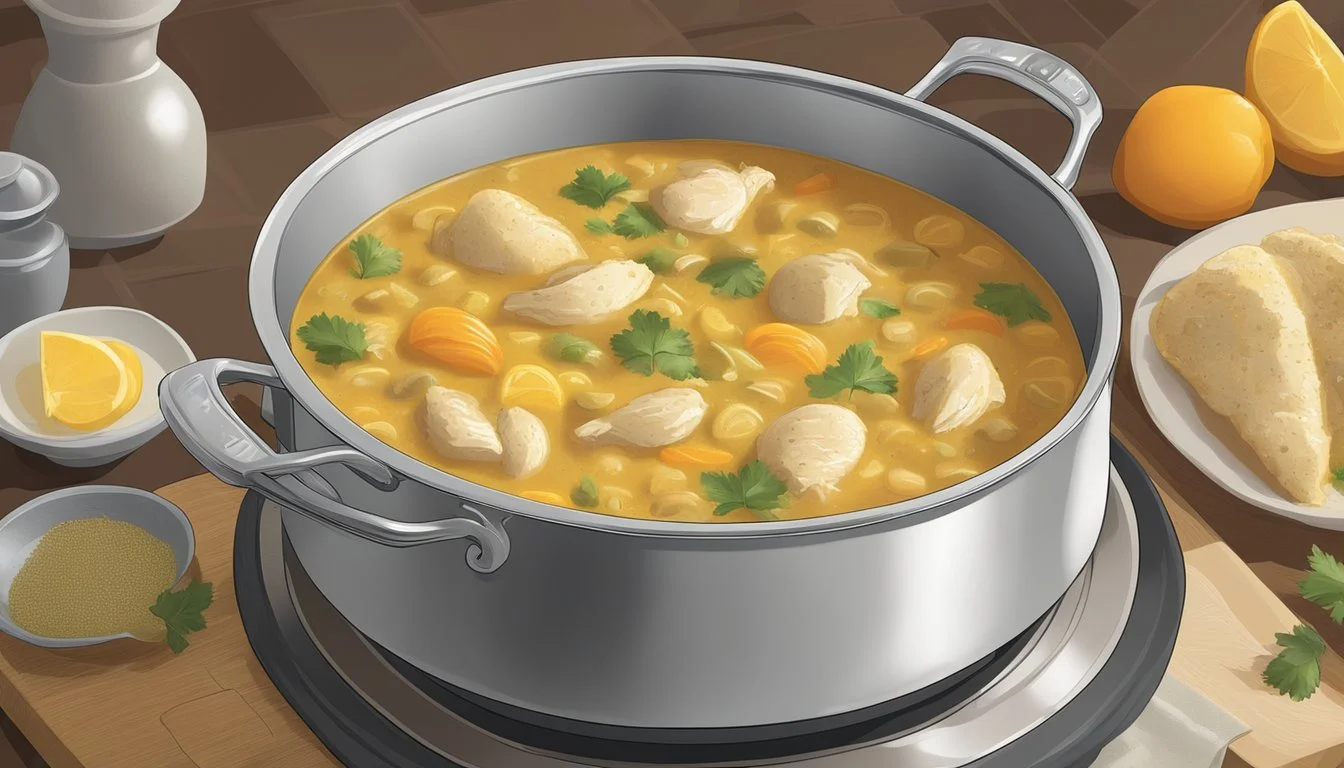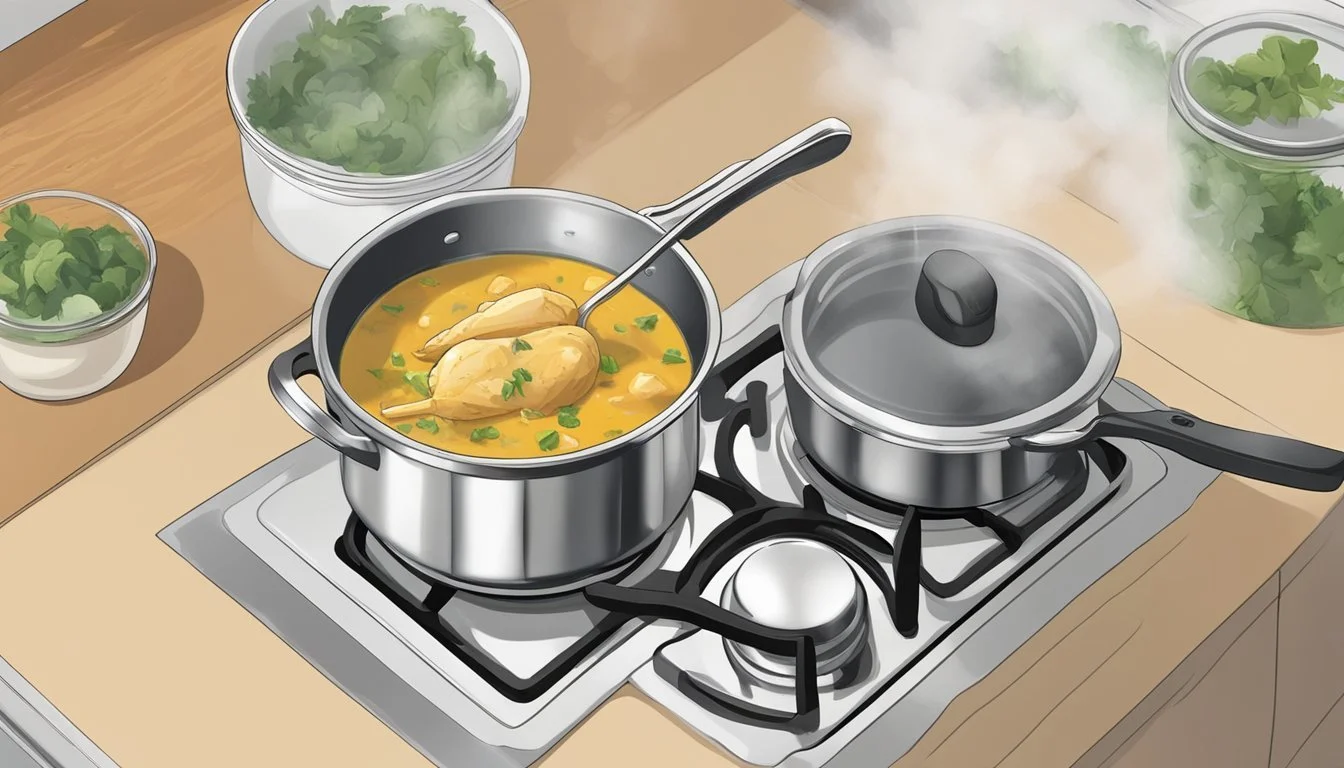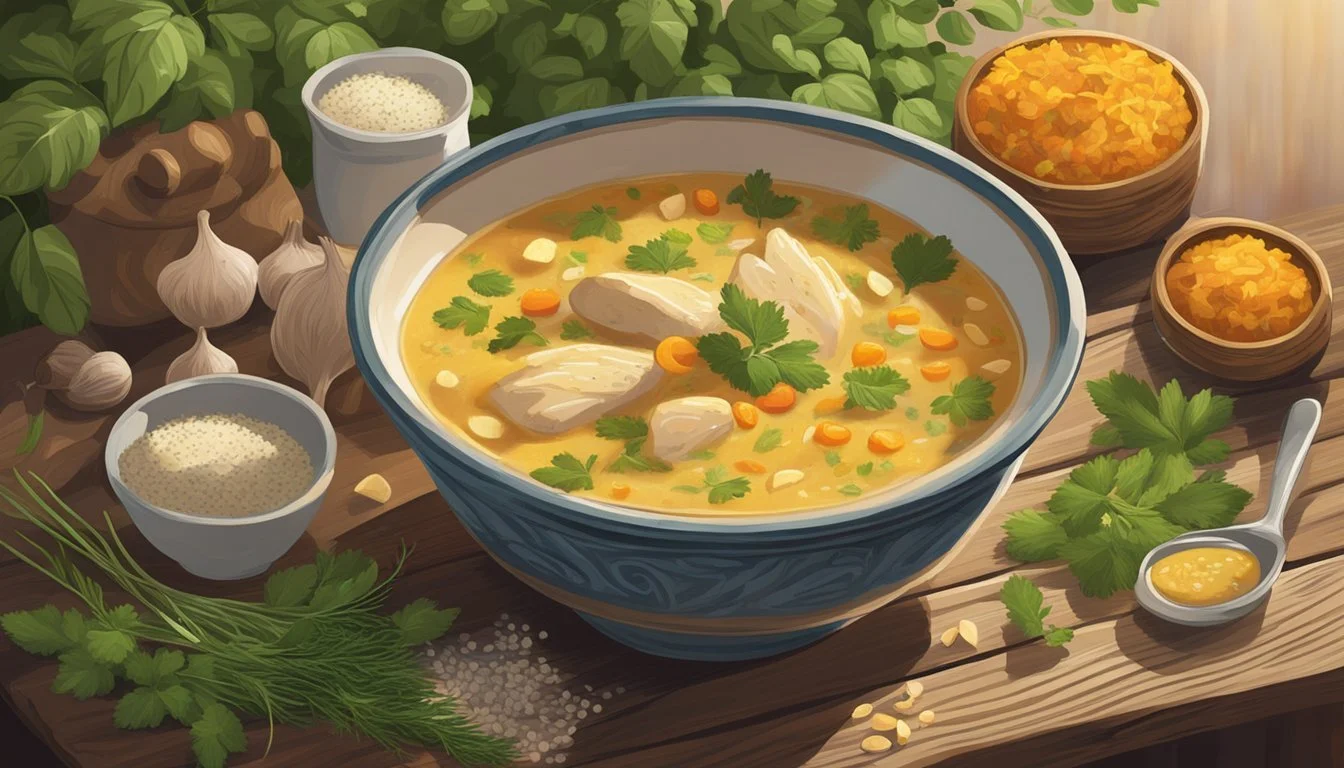Best Way to Reheat Chicken Mulligatawny Soup
Tips for Maintaining Creaminess and Flavor
When reheating Chicken Mulligatawny Soup, preserving its creaminess and flavor is crucial. This hearty, spiced soup, fusion of Indian flavors and British colonial history, combines tender chicken with aromatic spices and rich, creamy elements. Its complexity of taste and texture is what makes it special, and improper reheating can compromise both.
The key to maintaining the soup's integrity is a gentle reheating process. Microwaving, while convenient, might unevenly distribute heat and cause the dairy components to separate. Instead, it's advisable to reheat the soup on the stove over a low to medium heat, stirring occasionally to ensure consistent warming throughout.
To protect the delicate creaminess of the soup, it's best not to let it boil. Boiling can be too harsh for the dairy ingredients and might dull the flavors of the spices. If the soup was stored in the refrigerator, allowing it to reach room temperature before reheating can also aid in an even warm-up, preventing the soup from curdling and keeping its savory profile intact.
Understanding Mulligatawny Soup
The essence of Chicken Mulligatawny Soup lies in its diverse blend of ingredients and the fusion of flavors that trace back to its origins. This rich, creamy dish has a history as layered as its taste, and understanding its components is crucial to preserving its integrity when reheating.
History and Origin
Mulligatawny is a soup that has deep roots linking to Indian cuisine and was adapted by British colonists during the colonial era. The name itself is derived from Tamil words "milagu" (pepper) and "tanni" (water), reflecting its initially spicy nature. Over time, the recipe evolved as it traveled westward, leading to the addition of various meats such as chicken, and becoming a more complex and satisfying dish that melds the lines between a soup and a stew.
Key Ingredients
Chicken: Usually the centerpiece, providing a meaty richness.
Vegetables: Commonly onions, celery, and carrots, adding texture and flavors.
Olive Oil: Used to sauté the vegetables, contributing a subtle note to the overall flavor.
Curry Powder & Garam Masala: Essential spices that give the soup its distinct warm and aromatic taste.
Chicken Stock: Forms the liquid base, enriching the broth with a savory depth.
Rice: Often basmati or long-grain; it absorbs the flavors and adds heartiness.
Cream or Coconut Milk: Introduces a velvety texture and slightly sweet notes.
Apple: An unusual but traditional ingredient, offering a hint of sweetness.
Lentils: Some versions include lentils for additional body and earthiness.
Key Creamy Contributors Role in Mulligatawny Soup Cream/Coconut Milk Adds creaminess and balances the spices Lentils Thickens the soup and contributes to the creamy texture
Each ingredient plays a pivotal role not only in taste but also in ensuring the soup's creaminess is maintained when reheating.
Preparation Tips Before Reheating
Proper preheating preparation sets the foundation for preserving the creaminess and flavor of Chicken Mulligatawny Soup. Attention to storage and preservation practices ensures that the texture and moisture of the ingredients remain intact.
Storing Procedures
Before reheating, one should ensure that the Chicken Mulligatawny Soup is stored correctly to maintain its quality. It should be:
Cooled to room temperature before storing to prevent condensation and bacteria growth.
Stored in an airtight container to help retain moisture and flavor.
Kept in the refrigerator if it will be reheated within a few days, or in the freezer for longer shelf life.
Freezing the soup requires a few additional steps:
Divide the soup into portion-sized containers to make reheating easier.
If using a container, leave a small gap at the top to allow for expansion as the soup freezes.
Utilize plastic wrap to press down on the surface of the soup before sealing to reduce air exposure and freezer burn.
Preservation Best Practices
The integrity of Chicken Mulligatawny Soup’s creamy texture depends on how it’s handled before reheating:
Ingredients such as rice or apples should be considered, as they can absorb excess moisture and become mushy.
To ensure consistency, it is key not to overfill containers, which could lead to uneven freezing and thawing.
A layer of plastic wrap can be used directly on the soup's surface before sealing with a lid to preserve moisture and protect against freezer burn.
When using an oven to reheat, it may be beneficial to cover the soup with foil or an oven-safe lid to retain moisture.
By following these guidelines, one safeguards the soup's quality, paving the way for a successful reheating process that brings out the best in this comforting dish.
Reheating Techniques
Proper reheating maintains the creamy texture and complex flavors of Chicken Mulligatawny Soup. The chosen method should ensure even heating and prevent separation of the liquid components.
Stovetop Method
To reheat on the stovetop, one should place the soup in a saucepan and warm it over medium heat. They must stir the soup occasionally to ensure even cooking and to prevent it from sticking to the bottom of the pan. If the soup appears too thick, they may add a bit of water or broth to adjust the consistency.
Oven Method
When using the oven, it's best to preheat the oven to 350 degrees Fahrenheit. The individual should transfer the soup into an oven-safe dish and cover it with aluminum foil to keep the moisture in. The soup typically should be heated for about 20-30 minutes, checking periodically. Stirring is not usually necessary due to the indirect heat.
Microwave Method
For the microwave, the soup should be placed in a microwave-safe bowl. To minimize splatter and ensure that the soup heats evenly, covering the bowl with a microwave-safe lid or plastic wrap with a vent is advisable. The soup should be heated in intervals of two minutes on medium power, stirring in between each interval to promote even cooking.
Retaining Flavor and Creaminess
When reheating Chicken Mulligatawny Soup, it's crucial to maintain its unique flavor and creamy texture. The right balance of heat and fresh ingredients can make all the difference in reviving leftovers.
Control Heat and Time
Low Heat: Gently warm the soup on low heat to prevent the cream base from separating and to ensure the flavors meld together without becoming bland.
Stir Constantly: Keep the soup moving with a spoon to distribute heat evenly and maintain creaminess.
Avoid Boiling: Boiling can make the soup grainy. Heat until it's just hot enough to serve.
Timing: Limit the heating time to only as long as necessary to reach serving temperature; overcooking can diminish flavor and texture.
Adding Fresh Ingredients
Fresh Cream: A splash of fresh cream can rejuvenate the soup's creamy consistency.
Seasoning: Adjust the seasoning with a pinch of salt, if necessary, to enhance the soup's flavor profile.
Fat Choice: Opt for unsalted butter or olive oil to add richness without overpowering the other flavors of the soup.
Herbs and Spices: Fresh herbs or a dash of the original spices can brighten up the leftovers and add a burst of flavor.
Safety and Nutrition
When reheating Chicken Mulligatawny Soup, one must consider both food safety and the nutritional integrity to ensure the dish remains a healthful choice. Proper reheating maintains the soup's rich flavors and creamy consistency, while also keeping it safe for consumption.
Food Safety Considerations
Reheating: Soup should be heated to an internal temperature of 165°F to eliminate any potential foodborne bacteria. This can be checked with a food thermometer.
Storage: Leftover chicken soup should be refrigerated within two hours of cooking and consumed within three to four days. For freezing, one should cool the soup quickly and freeze it in moisture-proof containers or bags.
Nutritional Content
Calories and Protein: Chicken Mulligatawny Soup can vary in caloric content, typically ranging from 150 to 250 calories per serving, with protein amounts often between 10 to 20 grams. This variation depends on the ingredients and portion sizes.
Nutrition Information: The soup is typically rich in nutrients due to its diverse ingredients. Here's a breakdown of the primary components:
Chicken: A source of high-quality protein, vitamins like B6, and minerals such as phosphorus.
Lentils and Rice: Provide complex carbohydrates, fiber, and additional protein, supporting energy levels and digestion.
Vegetables and Spices: Ingredients such as carrots, celery, and curry powder contribute vitamins, antioxidants, and anti-inflammatory properties.
Remember to factor in any additions such as cream or extra butter which can increase the caloric value while also enhancing the flavor and texture of the soup.
Serving Suggestions
Reheating Chicken Mulligatawny Soup offers a wonderful opportunity to further enhance its rich flavors and creamy texture. With the right side dishes and final garnishes, one can elevate this hearty soup into a complete and satisfying meal.
Complementary Side Dishes
Naan: This traditional Indian flatbread is an excellent choice for dipping into the soup, allowing it to absorb the robust curry flavors.
Lentil Soup: For those looking for a vegetarian option, a side of creamy lentil soup can complement the chicken mulligatawny by providing both a textural and flavor contrast.
Final Touches for Enhancement
Cilantro: A sprinkle of fresh chopped cilantro can add a burst of color and a hint of citrusy freshness to the dish.
Curry Powder: A light dusting of curry powder before serving can intensify the flavor, appealing to those who enjoy a stronger curry presence in their soup.
Alternative Approaches
When reheating Chicken Mulligatawny Soup, preserving the creaminess and robust flavor is essential. Alternative approaches focus on variations that cater to different dietary preferences while enhancing the soup's complex profile.
Vegetarian Variations
For a vegetarian twist on Chicken Mulligatawny Soup, chefs often substitute chicken with hearty vegetables or legumes. South Indian influences can be woven into the soup by incorporating regional vegetables like okra and drumsticks, adding depth to the flavor profile. A common addition is:
Chickpeas or lentils for their texture and protein content
Fusion techniques may involve blending spices from various cuisines to create a unique flavor scape. The use of coconut milk instead of cream could add both richness and a distinct South Indian savor, while keeping the dish vegetarian.
Meat-Based Alternatives
When looking at meat-based alternatives, one can explore various options beyond the traditional chicken breasts. Different meats can transform the dish, offering new dimensions of taste:
Lamb, slow-cooked to tender perfection, can replace chicken to introduce a more robust and earthy flavor.
Beef or bacon could be used for their rich and smoky undertones, adding a hearty element to the soup.
For poultry variations, chefs may opt for chicken thighs over breasts, as thighs are often juicier and more flavorful, enhancing the overall savor of the Mulligatawny. No matter the meat chosen, proper seasoning with salt and pepper along with traditional spices is critical for maintaining the distinctive taste of the soup.
Common Questions and Troubleshooting
When reheating Chicken Mulligatawny Soup, it is essential to maintain its creaminess and the layers of flavor that make it unique. This section addresses potential missteps and provides answers to frequently asked questions to ensure a successful reheating process.
Reheating Common Mistakes
Stovetop Reheating: Using a skillet or a Dutch oven, heat the soup over a low to medium setting. A common mistake is applying high heat, which can cause the soup, especially if it contains heavy cream, to separate or become grainy. Gentle reheating is key.
Microwave Reheating: If using a microwave, one should avoid reheating at full power as this can unevenly heat the soup and affect its texture. Instead, opt for short intervals at a lower power setting, stirring in between.
Avoiding Sogginess: If the soup contains elements meant to be crispy, such as croutons or fried onions, add these after reheating to preserve their texture.
FAQs on Chicken Mulligatawny Soup
How can I save time when reheating Chicken Mulligatawny Soup? It's advised to reheat only the amount needed for one serving to save time and preserve quality.
Can I add water or stock when reheating if the soup has thickened? Yes. Adding a small amount of chicken broth or water can help restore the original consistency. Heat the soup, then gradually add liquid until the desired consistency is reached.
How do I store leftover Chicken Mulligatawny Soup? Store the soup in an airtight container and refrigerate it. Proper storage minimizes the risk of bacterial growth and helps maintain flavor.
What's the best way to reheat Chicken Mulligatawny Soup that contains heavy cream? Reheat the soup on a low heat setting, stirring frequently to prevent the cream from separating.
If the soup's flavor has diminished after storage, how can I enhance it? Gently simmer the soup and consider adding fresh herbs or a squeeze of lemon juice to brighten the flavors just before serving.
Conclusion
To reheat Chicken Mulligatawny Soup while preserving its comforting creaminess and robust flavor, one should approach the task with care. The best way includes gently warming the soup on the stovetop using medium heat, stirring occasionally to prevent separation and maintain an even distribution of heat.
Following these steps ensures the soup's flavor profile is retained:
Stovetop reheating: Pour the soup into a pot and heat it on medium, stirring regularly.
Microwave reheating: Place the soup in a microwave-safe bowl, cover to retain moisture, and heat in short intervals, stirring in between.
It's important to avoid overheating to keep the chicken tender. One should reheat until just hot enough to serve, which usually means reaching an internal temperature of 165°F (74°C) for safety.
By taking this careful approach, one honors the flavors and textures of this flavorful dish, ensuring each reheated serving is as delightful as the first.
Additional Resources
For those eager to perfect their Chicken Mulligatawny Soup reheating technique, a variety of resources are available to ensure that its creaminess and flavor are preserved. Interested cooks can consider the following materials to enhance their culinary skills:
Books:
The Ultimate Soup Cookbook: This resource offers an array of soup recipes, including Mulligatawny and methods to reheat soups (What wine goes well with soups?) while retaining flavor and texture.
The Chicken Soup Manifesto: Readers find international chicken soup recipes and reheating practices.
Websites:
Serious Eats: A site for culinary enthusiasts, providing detailed articles about soup reheating and recipe modifications.
Food Network: Contains an extensive collection of chicken soup recipes with expert advice on reheating techniques.
Video Tutorials:
Cooking Channels on YouTube: Channels such as "Bon Appétit" and "Food Wishes" offer step-by-step video guides on reheating soups.
Cooking Forums:
Online forums like ChefTalk or eGullet where professional and amateur chefs discuss methods for maintaining the integrity of reheated soups.
Recipe Variations:
Those looking to experiment with variations of Mulligatawny Soup can consult international cooking websites that explore diverse cultural takes on this classic dish.
Cultural References:
Fans of Seinfeld can recall the episode "The Soup Nazi" for its humorous take on soup enthusiasts. While not instructive, it certainly celebrates the passion surrounding iconic soup recipes and may inspire a fun approach to cooking.
By utilizing these resources, cooks can remain confident in their ability to reheat Chicken Mulligatawny Soup without compromising on its beloved creamy texture and rich flavor. The recommended materials provide clear instructions and knowledgeable insights suited for both novice and experienced soup aficionados.






